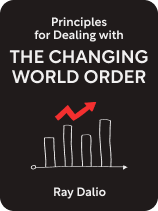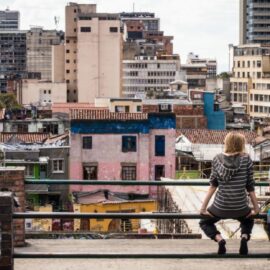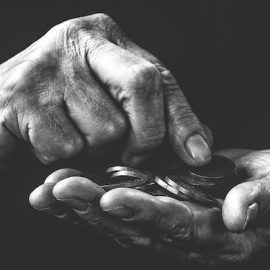

This article is an excerpt from the Shortform book guide to "Principles for Dealing with the Changing World Order" by Ray Dalio. Shortform has the world's best summaries and analyses of books you should be reading.
Like this article? Sign up for a free trial here.
How does history unfold in cycles? What can we learn from studying these patterns?
Principles for Dealing with the Changing World Order by Ray Dalio explores the cyclical nature of history and its impact on global powers. Dalio examines how empires rise and fall, economies expand and contract, and societies experience periods of harmony and discord.
Keep reading for our overview of this book, and discover Dalio’s insights on navigating an uncertain future in a changing world.
Principles for Dealing With the Changing World Order
Principles for Dealing with the Changing World Order by Ray Dalio, published in 2021, explains his model of world history and the method he uses to make decisions in light of that model. Dalio’s model, based on his personal research and complemented by sophisticated computer systems, describes the major political and economic patterns that characterize our world, past and present. For Dalio, it represents his lifelong effort to make sense of the world in order to make better decisions as a learner and an investor.
Dalio is an American billionaire investor and founder of Bridgewater Associates, one of the world’s largest hedge funds. He’s known for the titular principles-based thinking that he describes in his books—which also include Principles: Life and Work (2017) and Principles for Navigating Big Debt Crises (2018). As a fund manager, he’s notable for having navigated major economic ups and downs with little impact to the accounts he manages.
Our overview covers the book in three parts:
- First, we explain Dalio’s contention that history unfolds through large-scale patterns of cause and effect with economic, sociopolitical, and geopolitical dimensions—and that by understanding these cycles, we can anticipate what’s coming and make better decisions.
- Second, we break down Dalio’s model of these patterns to detail each dimension and how they relate.
- Third, we discuss how Dalio recommends you use his model as mental models to improve your thinking. We also cover his thoughts on what may happen in the near future, which pertain chiefly to the United States and China.
How History Unfolds as Cyclical Struggles for Wealth and Power
We’ll introduce the basic terms of Dalio’s model, and we’ll explain how it centers on the competition for wealth and power, which Dalio says is central to human history. We’ll then discuss the main pattern that he derived from his studies of the many historical instances of this competition—the rising and falling of many world powers.
Basic Concepts: Cycles, Evolution, and Human Inventiveness
Dalio contends that human history evolves through cycles. In his view, these evolving cycles center on the rising and falling of major powers (“empires”) and the world orders they create. This major cycle transpires roughly every 250 years and follows roughly the same broad pattern each time. For instance, the ways in which the Spanish, Dutch, and British Empires fought for, established, and managed their wealth and power have much in common. From many such examples, Dalio says, he derived a general pattern that describes all such cycles in a more-or-less accurate way.
Cycles, in Dalio’s model, are the cause-and-effect sequences of events that describe how empires rise, peak, and fall. Cycles drive the natural oscillation of the world between peace and war, prosperity and poverty, and the concentration of wealth and power here, there, or elsewhere.
Evolution, on the other hand, is the gradual accumulation of changes that build up as cycles unfold. Dalio says that during each cycle, humanity makes net gains that persist past the end of the cycle, such that we stand today on the shoulders of gains made through thousands of years of historical cycles.
Together, Dalio says that cycles and evolution lend a net positive trajectory to the unfolding of human history. Driving this upward movement is human inventiveness: According to Dalio, humanity’s innate drive to progress—to invent tools and technologies, to shape our environments, and to seek ever greater mastery of the world—makes the world steadily better over time.
Understanding this pattern matters, according to Dalio, because it allows us to see where we are, here and now, in the broader sweep of history. And, if we know where we are in the current major cycle, we can anticipate what comes next in order to better navigate life, business, investment, and so on.
The Competition For Wealth and Power: Rises, Peaks, and Falls
According to Dalio, humans have competed for wealth and power throughout history. He explains that, in studying the major world empires across the past few thousand years (though he focused on the most recent 500 years), he learned that people naturally fight over resources such as favorable land and food supplies. These basic resources can give one group an advantage over others, such as the ancient Egyptians who dominated the fertile Nile river valley.
With a resource advantage, a group can concentrate wealth, build a military advantage, and extend their dominance over larger areas. This pattern of competition, accumulation, and extension of dominion is the pattern on which Dalio’s model centers. It happens because, Dalio argues, basic emotions like fear, greed, and jealousy drive people to fight over the resources upon which survival depends.
While Dalio derived his model from years of study of over a dozen major historical empires, it isn’t meant to be exact and can’t predict the future. Regardless, he believes it to be an accurate model of the logical sequences of causes and effects that govern how empires rise, peak, and fall.
First, Empires Arise, Advance, and Gain Advantages
According to Dalio, all new orders emerge from periods of disorder. In other words, any empire rises from the ashes of a previous ruling power. Coming out of the preceding period of disorder, the new ruling group displays several key elements.
Strong leaders build the new order: They devise economic and sociopolitical institutions meant to develop the wealth and power of their group. They emphasize education and values such as work ethic in order to encourage the development of a productive, prosperous, and inventive society.
A wealth-generating class emerges: Ambitious types such as merchants, inventors, artisans, and financiers work to develop technologies and, in turn, bring wealth to themselves and thereby their country. This class of wealth-earners tends to cooperate with the government and military to stabilize and maintain their emerging order with laws that support and enable their status quo.
With a burgeoning economy and civil society, a rising nation tends to gain a large share of world trade. The actors that directly hold power tend to be the economic and political elites, as well as top military brass, and they work together to protect their nascent nation. The government will typically invest in its military, which can protect trade routes and defend borders. At the same, they’ll reinvest their accumulating wealth into education, the economy, and other civil institutions that further improve quality of life for those in the home center of the empire.
The economy becomes more advanced: Around the same time, high concentrations of wealth give rise to financial institutions such as banks and markets. Banks can give loans, which fuel productive economic activity by giving people leverage beyond the hard capital they hold. In time, strong financial systems lead to the emergence of a major financial center—today, these include New York, London, and Shanghai—that allows the country to further consolidate its wealth.
With a dominant position in world trade and finance, the increasingly powerful nation tends to become the holder of the reserve currency—the stable currency against which all other currencies, on the international scene, get measured. Because people prefer to operate in a stable reserve currency, even more wealth flows through the financial systems of this nation.
Shortform Example: The United States
These dynamics unfold not immediately, but over many years—often decades or longer. As an example, consider the beginnings of the United States:
- After a violent revolution to break away from England, well-educated leaders came together to outline a new government and society.
- Drawing from Protestantism, early American society emphasized moral discipline, a steadfast work ethic, and civil cooperation. Opportunity was abundant, and the gaps between the haves and have-nots were small relative to today.
- Innovators such as Thomas Edison and Benjamin Franklin created numerous useful technologies, pioneered new ideas, and advanced civil society.
- The Industrial Revolution in the US saw the invention of even more new technologies and the creation of much wealth. Meanwhile, New York was growing as a strong financial center that would eventually have global importance.
- The US weathered the Great Depression in the 1930s, and then rose to the status of a political, economic, and military superpower after playing a leading role in the Allied victory in World War II.
- Today, the US dollar is the world’s reserve currency—a key indicator of the pattern Dalio describes above—and New York City is the world’s leading financial center.
Second, Empires Peak, Stall, and Weaken
When a major power has prospered for a time, the features described above—strong finances, robust civil society, and an advantageous geopolitical position—tend to weaken. In brief, prosperity leads to comfort and complacency that begins to erode the power’s strengths.
Socioeconomic mobility decreases: Financially, people tend to think that good times will continue, so they spend and take on debt accordingly. Debt increases across the board, people have less spending power, and so socioeconomic mobility decreases.
Wealth gaps appear: During a power’s rise, some people—usually a small minority—get very rich while others remain middle class or, more likely, quite poor. Socioeconomic class divides become more apparent as a power reaches its peak and early optimism wanes.
The economy becomes less competitive: Since the power is still relatively wealthy per capita, its workers become less competitive on the global market. For instance, it costs much more to employ a European or North American employee than one from South Asia.
Technological advantages diminish: Meanwhile, the technologies and inventions that brought wealth to the power begin to spread, so it alone no longer benefits from them as a source of wealth and prestige. For instance, industrial methods that originated in England spread to the rest of Europe and to the United States—and later, to much of the world.
Civil character weakens: Among the wealthy “haves,” people have become used to wealth and leisure—used to living the good life. Born into prosperity, they don’t care for the hard work it takes to maintain it and are unprepared for challenging economic and political circumstances. At the same time, the “haves” use their power to influence the political system to advantage themselves and their children. This exacerbates the growing gaps in values and wealth between them and the “have-nots,” fueling resentment along class divides.
The empire becomes unprofitable: Finally, large empires become unprofitable. The cost to maintain military protection of dominance over trade routes and geopolitical positions becomes a net loss of capital; and holding the reserve currency often leads a power’s leaders to slacken up on financial discipline. Major actors tend to borrow in excess and build up large debts to foreign lenders.
Eventually, funds run dry and the power struggles to finance itself. At this point, wealthy investors who remain mobile tend to exit their investments. In other words, they move their wealth out of holdings in the major power’s currency and businesses. This capital flight further weakens the economic bases of the power.
Third, Empires Unravel and End
After rising, then peaking and beginning to slow, a power tilts toward a fall. Weakened by a declining civil society and eroded financial, political, and military strength, the major power typically goes through a period of internal disorder. In turn, this can catalyze external disorder—change on the world stage, between powers—if the power doesn’t restabilize. Most often, Dalio says, falls lead to violent revolutions and new orders.
The catalyzing event is often an economic crisis. When large debt burdens coincide with an economic downturn, a power can find itself in financial as well as sociopolitical crisis. If the country can’t pay off its debts, it has to either default or print large amounts of money. According to Dalio, it usually chooses the latter..)
Printing large amounts of money causes inflation, which, in turn, devalues a currency and brings about economic hardship. When this hardship coincides with the gaps in wealth and values that became apparent during the peak, a power can experience harsh political conflict. In many cases, populism rises up. Populist leaders appeal to the values of the disenfranchised have-nots, and they sometimes try to reform the existing order to redistribute wealth from the rich to the poor.
Wealthy people want to hold onto their wealth, so they often leave nations that try to serve the general population more than the rich. To avoid high taxes or more extreme redistribution measures, they reinvest, move their holdings into different currencies, and relocate. As wealth floods out from a major power’s borders, its economic base grows even weaker. Dalio says that the government may close the borders to prevent capital flight. Meanwhile, prevailing economic hardship means that productivity continues falling, so less new wealth gets generated and there’s less to go around.
In this increasingly impoverished and disordered situation, autocratic leaders often emerge to take control, promising order and restoration (think of Adolf Hitler’s seizure of power in Germany, at the time a poor and conflicted country in the years between World War I and World War II). This often leads to outright conflict that escalates into revolution—sometimes peaceful, but most often violent—after which the winners create a new economic and political system, and the cycle begins anew.
The Three Dimensions of Dalio’s Model
Now that we’ve established the overarching pattern of causes and effects that Dalio describes, we’ll explain the key takeaways from the financial or economic dimension (how economies cycle), the sociopolitical dimension (how societies cycle), and the geopolitical dimension (how international world systems cycle) of this model.
The Financial Dimension: Credit, Debt, and Economic Cycles
First, Dalio explains that all economies go through debt cycles that typically last around 50 to 75 years. In other words, an economy cycles through phases of increased debt and credit use, or leverage, and phases of lessened debt and credit use, or deleveraging. Expansion and contraction are both natural and inevitable: Major powers go through periods of prosperity and periods of austerity, and this reflects in their economy. Debt and credit enable wealth building and prosperity, but because people tend to overextend financially, contraction always follows expansion.
For instance, recall how in 2008, the US housing market ballooned during a period of seeming prosperity—banks handed out big loans left and right. But when the bubble burst and many borrowers couldn’t pay off their debts (not to mention that many of the loans were predatory) a number of major banks ended up defaulting and needing bailouts from the US Federal Reserve.
According to Dalio, this oscillation between expansion and contraction of an economy is a natural feature of economic systems and has occurred throughout history. He explains that the most recent cycle began in 1945, when the US-led world order took over after WWII. A major power often experiences several of these economic cycles before a final, major downturn contributes to its demise.
The Sociopolitical Dimension: Internal Cycles of Harmony and Disharmony
As these economic cycles unfold, a major power’s civil society develops in particular ways. That society is organized as a sociopolitical system made of spoken and unspoken rules and norms that govern how large groups of people work and live together.
Just like economies, societies fluctuate between periods of harmony and periods of disharmony. At times, people generally get along and work well together, and at other times, discord, strife, and conflict tend to arise between classes within a society.
Dalio describes societies as progressing through three stages of building harmony, wherein people cooperate and economic activity flourishes, and three stages of increasing disharmony, wherein civil society degrades and falls apart.
Most sociopolitical cycles end in violence, such as civil war or revolution, which are an inevitable fact of life, Dalio argues. This is because any society benefits a certain small class over most others (such as how capitalism privileges those who own the means of production), so the unprivileged majority eventually becomes dissatisfied with the status quo. Conflict breaks out over values, how to distribute wealth and power, and who should be in charge. Generally, a revolution succeeds when it yields broad economic prosperity for the previously unprivileged.
The Geopolitical Dimension: External Cycles of Peace and Conflict
Much like a major power’s internal society, there’s an international order between different world powers. According to Dalio, it also follows a six-stage cycle that progresses through times of peace (building, growing, peaking) and times of conflict (overextending, declining, and dissolving through revolution or war). However, while a nation can structure its society through enforceable laws and punishments that guide citizens’ behavior, there is no broadly enforceable legal system on the international scale. Instead, the major powers, with their large militaries, tend to act in their own interests. For instance, entities like the UN can’t outright control the US, which holds dominant military and economic power.
Instead, only other powerful countries can exert influence on one another, like how the US and China must acknowledge one another as rival actors. And, Dalio suggests, wealth and power accumulate on the global scale much like they do within a nation. Mirroring the cooperation of wealthy individuals within a nation, wealthy nations tend first to seek win-win relationships to establish a geopolitical system that benefits them both. However, Dalio says they always devolve into conflict—typically when an ascending power wants to take the reins from a declining power. He describes five kinds of conflicts, ranging from economic fights over trade and tariffs, fights over access to technologies such as computer chips, disputes over borders and territories, conflict over international debt, credit, and bank access, and finally violent conflict, or “hot” war.
If violent war breaks out, the powers that “win” get to determine the new international order. For instance, the winning nations of WWI created the League of Nations, a short-lived international system that attempted to prevent another brutal, global-scale war.
Dalio’s Predictions: The US Weakens, China Strengthens
With Dalio’s main models and concepts covered, we’ll end this overview by discussing his thoughts on anticipating the future. Specifically, we’ll discuss his predictions regarding the United States and China as the two major powers to watch on the global stage, and we’ll explain how to prepare for an ultimately uncertain future.
The US and China: Four Factors to Watch
To anticipate what’s next in the world’s cycles, Dalio asserts that you must watch for the signals that indicate what major shifts will most likely occur. He calls back to four key concepts: human inventiveness and the three dimensions of the main pattern.
Human Inventiveness
Human inventiveness: Given the many spectacular inventions of the past—from electricity to vaccines—and due to advances in AI and quantum computing, Dalio is optimistic about human progress continuing. The US and China will lead this progress, as both have productive, innovative workforces and economies.
Debt and Economic Cycles
Debt and financial cycles: Dalio says the US Dollar is in decline as a reserve currency, as the US is late in its cycle as a major power. High US debt will likely lead to the dollar weakening, whereas China has moderate debt and the renminbi (China’s currency) is on the rise.
Sociopolitical Cycles
Sociopolitical cycles: According to Dalio, the US shows strong signs of internal turmoil and may be heading toward more serious fragmentation. Increasing levels of political polarization, values gaps, and financial uncertainty mean that the US could descend into a period of possibly violent restructuring—Dalio suggests a 30% chance of a civil war-like event within 10 to 15 years.
However, he also argues that the US has weathered more political turmoil than most empires do, having persisted through 250 years that saw a civil war, multiple major depressions and world wars, and other major civil conflicts. While Dalio says it would be difficult—given the US’s high international debt, weakened political standing, and high levels of internal conflict—the country could manage by recognizing the decline and aiming for a nonviolent restructuring.
China, on the other hand, is presently in a period of peace and prosperity. They have relatively strong economic fundamentals (low debt, high productivity) and a strong civil society with low conflict over values and wealth distribution. While he doesn’t go into great detail, Dalio expresses optimism about China.
Geopolitical Cycles
In the global order, Dalio explains that the US and China are the two major powers to watch. He contends that they’re engaged in four of the five types of war: Economic, technological, geopolitical, and capital conflicts. For instance, both countries have long been engaged in tense diplomacy regarding activities in the South China Sea. These conflicts will intensify as China becomes more competitive as a global power.
Additionally, the US military remains the strongest in the world. However, China’s is nearly comparable and is growing, particularly across Asia—from the Koreas and Southeast Asia to India and Pakistan. Dalio estimates a 35% chance of a hot war within 10 years, and he says it would likely break out over Taiwan, a major pain point between the two powers. If we’re lucky, he says the tenet of “mutually assured destruction” may prevent outright military conflict on a global scale.
Dalio on How to Prepare for the Future
Though he expresses confidence in the above predictions, Dalio also recommends learning how to deal with what you don’t know. He stresses that all of these indicators and predictions are, in the end, educated guesses, and that we can’t predict everything. While history does “rhyme” in some ways, it’s also full of unpredictable happenings, such as the industrial and microcomputing revolutions as well as major political revolutions, like the movement away from feudalism and toward modern democracy.
To deal with unpredictability, Dalio says you must expect to be surprised and, when you are, be ready to adapt. While he doesn’t explain exactly how to do this (that’s the difficulty with unpredictable events), he advises that you stay aware of major political and economic trends around the world so that you can adapt when major events begin to suggest themselves.
In addition to good guesses, Dalio explains how to make good decisions in the face of uncertainty:
- Prepare for the worst. Based on the probable futures his model predicts, Dalio stashes backup funds in safe accounts or in physical stores like precious metals. This ensures he can provide for his family if things go south politically, economically, or otherwise.
- Diversify your bets. Develop a portfolio that isn’t limited by boundaries between industries or borders—invest in multiple countries and in multiple sectors of the economy. Be prepared to move your money across borders if need be.
- Learn from the smartest people you know. Look for others who anticipate the future, and discuss your principles and ways of thinking with them. This way, you’ll enrich one another’s mental models and can improve your bets together.
Last, Dalio gives a general recommendation that we bet on things getting better. While major periods of downturn and destruction could happen in our lifetimes—wars, natural disasters, and major restructurings of the world’s systems have all been common in the past—things also tend to improve. Human life has steadily improved throughout history, Dalio says, and human inventiveness will continue to drive that positive evolution.

———End of Preview———
Like what you just read? Read the rest of the world's best book summary and analysis of Ray Dalio's "Principles for Dealing with the Changing World Order" at Shortform.
Here's what you'll find in our full Principles for Dealing with the Changing World Order summary:
- How to use patterns in world history to make better decisions today
- What may happen in the near future for the United States and China
- Why humans are stuck in a competition for wealth and power






